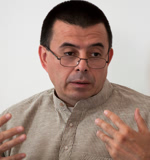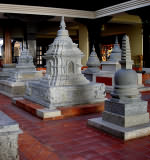Az Indo-európai nyelvek eredete 2. Rész
A tárgykör mélyebb tanulmányozása
Introduction: New Contributions
Hi, this is Andrés Muni. Firstly, I want to say that this document is based on the studies of Colin Renfrew, a renowned linguist and archaelogist.
The traditional view of the Indo-European languages' spreading maintains that right in the beginning of the Bronze Age, hordes of nomadic horsemen inhabitating the present western Russia spoke in a primeval language. As the warriors extended their territory by conquering foreign lands, they subdued the indigenous populations and imposed them their own Proto-Indo-European language.
As centuries went by, this language would be transformed in every region into the present Indo-European languages. However, according to new investigations, Indo-European languages were not spread through conquests, but in a peaceful manner. This viewpoint is consistent with the propagation of agriculture from Anatolia and Near East.
The problem with the origin of Indo-European language is examined from a linguistic point of view. When the linguists investigated the Indo-European languages, they discovered that those languages were related to each other. There are similarities among many European languages and Sanskrit, while such languages as Chinese and Japanese do not belong to the same branch.
By means of even more detailed comparisons, we will be able to subdivide the European languages into branches.
| BRANCH OF THE ROMANCE LANGUAGES | French, Italian, Spanish, Portuguese and Rumanian. Formed from the languages being derived from Latin. |
| BRANCH OF THE SLAVIC LANGUAGES | Russian, Polish, Czech, Slovak, Serbo-Croatian and Bulgarian. |
| BRANCH OF THE GERMANIC LANGUAGES | German, Norwegian, Danish and Swedish. |
Only a few languages (Hungarian, Finnish and Basque) are left excluded from the Indo-European family. Let's deepen now.
Going deep
There are four main kinds of models to interpret the language's process of change.
| PROCESS OF INITIAL COLONIZATION | When a uninhabited territory is settled, the language of this region will be, naturally, that of the settlers. |
| PROCESS OF DIVERGENCE | When the languages separate from one another, they start differentiating from each other more and more. And the subsequent dialects will diversify and they will become different languages. |
| PROCESS OF CONVERGENCE | The linguistic changes will propagate as big waves, which will converge in the end. That is to say, the big waves will bring about similarities among languages that differed absolutely from each other in the beginning |
| PROCESS OF LINGUISTIC SUBSTITUTION | The languages of settlers coming from other regions substitute, completely or partially, the languages spoken by the indigenous populations. |
This last model is the key to explain the origins of the Indo-European languages. One language may replace other in various ways within a particular region:
1) People inhabitating a region usually have a well established economy of subsistence (basic economy). That economy, whether it is based on hunting and fortuitous gathering or on farms, will prove adequate to sustain those people. If a group of newcomers attempts to settle in that region in a peaceful way, then this group must have a number of techniques. These techniques should allow them either to exploit a different ecological resource, or to compete successfully with the local exploitation.
2) When the immigrating group is well organized and has better military techniques, it can get control of the social system of that region and dominate it by force. This dominion of an élite needs some previous requirements to success:
a) Having a superior military technology.
b) The immigrating group will have to be adequately organized to get control of.
c) The indigenous society will have to be extremely well organized if it wants to survive.
3) When a very centralized society collapses, the neighboring populations which had been kept at bay up to that moment, take advantage of that absence of central power and invade the territory (just as the barbarians did when the Roman Empire collapsed). In this case, the language of the empire may be replaced by that of the invaders.
4) When there is a remarkable foreign trade within an equalitarian society, a commercial language (lingua franca) is very often developed. If the lingua franca starts being used as a mother tongue by some native people, it is transformed into a "domestic" language. This transformation is a kind of substitution and currently it is considered to be an important aspect of the linguistic development.
When these forms of linguistic substitution (demographical change and subsistence, dominion of an élite, collapse of the system and lingua franca) are applied to the European history and prehistory, then:
a) Both the dominion of an élite and the ruin of a system requiere a level of social organization which did not exist before the Bronze Age.
b) It is not very probable that there would be in Europe, before that time, a commercial system intense enough as to encourage the development of a lingua franca.
This inference only leads us to the first model (demographical change and subsistence). Thus, in the European prehistory a world-wide fact bringing about radical effects is to be noted: "the development of agriculture". This fact fits perfectly in the first category.
In the 7th millennium BC a new agricultural economy, based on wheat and barley cultivation and on sheeps and goats shepherding, spread throughout Europe. These species were imported to Europe. It appears to be that the domestication of these species occured simultaneously in several neighboring regions of Near East. However, they were brought in Europe from Central Anatolia (present Turkey).
According to Albert J. Ammerman and Luca Cavalli-Sforza hypothesis (both of them belonging to Standford University), that spreading of agriculture generates a model named "advancing wave". This model states that the agricultural economy was transmitted by the local movements of the farmers and their progenies. When the agriculture occupied a particular zone, the demographical density would increase quickly there. Ammerman and Cavalli-Sforza indicate that the agriculture would have increased the demographical density 50 more times than the previous hunting and fortuitous gathering economies.
Going even deeper
Agriculture could have spread throughout Europe as a wave advancing approximately 1 km per year. At this speed, 1500 years would be required for agriculture to spread from Anatolia to Northern Europe, which is coincidental with the present archaeological data.
The model of the advancing wave is not the only one to be applied. As indicated by the archaelogist Marek Zvelevil of Sheffield University, if the local population of hunters-gatherers had adopted the agriculture of their neighbors, the spreading of agriculture might have been slower and with no linguistic substitution. The farmers would be the natives instead of newcomers speaking in their own language which was new to the indigenous people. Probably, the reality is a mixture of these 2 processes:
"Agriculture might have been brought in Greece by foreigners. Afterward, it spread toward Balkans,
Central Europe and Southern Italy. But in other regions, agriculture might have been adopted
by the indigenous population".
This would explain the persistence of several non-Indo-European languages such as:
a) Basque language, which has survived up to this moment.
b) Etruscan language of Central Italy, which survived up to the Roman times.
c) Archaic Iberian language, in Spain.
d) Pictish, preceltic language of Scotland.
Thus, the description about how Indo-European language was brought in Europe maintains that the immigrants came from Anatolia and that they had arrived in Europe about 6500 BC. These first Indo-European inhabitants were not invading warriors with a society centrally organized, but farmers whose societies were equalitarian ones. And in the course of a generation (25 years), maybe they just moved a few kilometers away from the place where they were born.
Concluding remarks
Well, I hope that you have learnt and enjoyed this second study about European languages. I tried to be as accurate as possible in this translation into English. The wall between English and Spanish languages is big. So, many mistakes are likely to happen. Sorry, I tried and will try my best. If you have found errors, please help me improve this website. Click here. This interesting version about Indo-European migrations has surely made your life richer. We will keep studying our ancestors in Part III. See you and take care.
Further Information
Ezt a dokumentumot Andrés Muni, a website egyik társalapítója készítette, aki a nyelvészetben jártas.
Szanszkrit, Yoga és indiai filozófiával kapcsolatosan, vagy ha csupán hozzászólni, kérdezni szeretnél, esetleg hibára felhívni a figyelmet, bátran lépj kapcsolatba velünk: Ez az e-mail címünk.





























